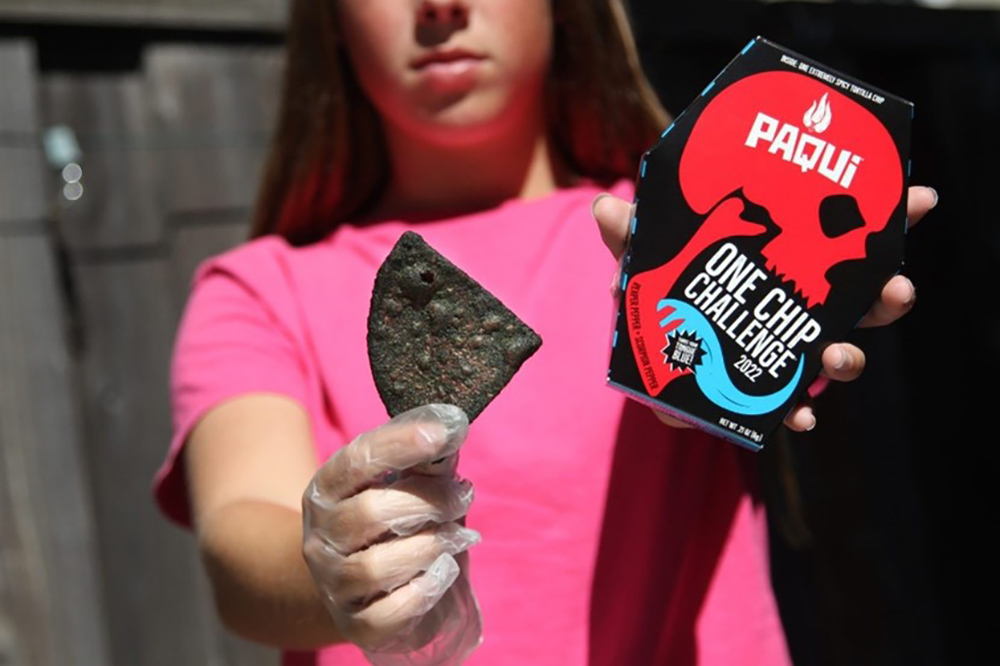
美国马萨诸塞州一起事件近期震惊了社会,14岁的哈里斯·沃罗巴(Harris Wolobah)因挑战食用全球最辣的薯片而被“辣死”。
在沃罗巴死亡后,一家玉米片制造商决定将其超辛辣产品“一片薯片挑战”下架,这再次引起了人们对类似挑战(由品牌营销并在网上广泛传播)的受欢迎程度和风险的关注。
辛辣食物挑战赛已经存在多年了。从当地的吃辣椒比赛到餐馆为那些吃完超辣菜肴的人设立的名人墙,世界各地的人们都在挑战彼此,看谁有胆量吃下超辣的食物。一些专家指出,这源自人们内在的竞争和冒险冲动。
但佛罗里达国际大学心理学副教授艾丽莎·特鲁科(Elisa Trucco)说,但专为挑战赛和(有可能)网络成名而生产和销售的超辣产品却是最近才出现的,而且由于社交媒体,青少年尤其容易接触到这些产品。
特鲁科说:“在社交媒体上,这些挑战被美化了。你会发现很多人‘点赞’或是评论这些挑战赛(彰显社会地位或受欢迎程度),但你无法看到很多负面后果——比如去急诊室或是造成其他伤害。”
美国东北大学(Northeastern University)市场营销学副教授亚历山大·德保利(Alexander DePaoli)补充说,人们可能会忍受痛苦完成挑战并在网上分享,以获得一种“群体归属感”,类似于现实生活中的真心话大冒险游戏。
例如,几年前,YouTube上一个名为“挑战超辣鸡翅”的系列视频在网上走红,视频记录了明星们吃辣鸡翅后的反应。与此同时,全国各地的餐厅也在不断提供现场挑战活动——从布法罗野生鸡翅餐厅“Blazin”挑战赛(Blazin' 酱汁是布法罗野生鸡翅餐厅最辣的酱汁)到拉斯维加斯鸡翅之王餐厅的“地狱挑战赛”(Hell Challenge)。在这两项挑战中,年满18岁的顾客可以尝试在不喝酒或不吃其他食物的情况下,在限定时间内吃掉一定量的浇上超辣酱汁的鸡翅。
世界各地也定期举办吃辣椒比赛。去年,格雷戈里·福斯特(Gregory Foste)在加州圣地亚哥创下33.15秒吃掉10个卡罗莱纳死神辣椒的记录(卡罗莱纳死神辣椒被吉尼斯世界纪录认证机构认定为世界最辣的辣椒)。
在大多数情况下,人们会选择参加那些他们受过训练或是认为并非真正危险的挑战。但德保利指出,当有人受到伤害时,就越过红线了。
虽然10年级学生沃罗巴的尸检结果尚未公布,但这名青少年的家人声称,“一片薯片挑战”是导致他9月1日死亡的罪魁祸首。这款产品是由Paqui公司生产的,提示参与者试吃“一片薯片挑战”薯片,然后看看他们在不吃其他食物和不喝水的情况下能坚持多久。
这种薯片的销售似乎主要靠人们在社交媒体上发布自己或朋友接受挑战的视频来带动。这些视频展示了人们(包括青少年和儿童)吃薯片后对辣味做出的反应。一些视频显示人们呕吐、咳嗽,并讨水喝。
自从沃洛巴死后,Paqui公司已经要求零售商停止销售这种产品。一些健康专家也指出,在某些情况下食用这种辛辣产品存在潜在危险,尤其取决于辣椒素的含量(辣椒素是辣味的决定因素)。
但是,网上和商店货架上仍有许多类似产品,包括Red Hot Reaper的"一片薯片挑战"、Blazing Foods的"死亡坚果挑战"和"恐怖玉米坚果挑战"以及Wilder Toys的"真心话大冒险游戏辣酱"。在Paqui公司撤下自己的产品后,美联社联系了上述公司,但没有收到回复。
德保利说,公司进行病毒式营销并不罕见。
他说:“然而,品牌真的希望你摄入某些食物并不常见。” 公司“不想为此承担责任”。
特鲁科补充说,尽管警告或标签上注明仅供成人使用,这些产品仍然可能落入不太了解其风险的青少年手中。
她说:“这些挑战之所以吸引人,是有原因的。这种营销方式能促进销售。”(财富中文网)
译者:中慧言-王芳
辛辣食物挑战赛不仅仅是轻松愉快的娱乐活动。
美国马萨诸塞州一起事件近期震惊了社会,14岁的哈里斯·沃罗巴(Harris Wolobah)因挑战食用全球最辣的薯片而被“辣死”。
在沃罗巴死亡后,一家玉米片制造商决定将其超辛辣产品“一片薯片挑战”下架,这再次引起了人们对类似挑战(由品牌营销并在网上广泛传播)的受欢迎程度和风险的关注。
辛辣食物挑战赛已经存在多年了。从当地的吃辣椒比赛到餐馆为那些吃完超辣菜肴的人设立的名人墙,世界各地的人们都在挑战彼此,看谁有胆量吃下超辣的食物。一些专家指出,这源自人们内在的竞争和冒险冲动。
但佛罗里达国际大学心理学副教授艾丽莎·特鲁科(Elisa Trucco)说,但专为挑战赛和(有可能)网络成名而生产和销售的超辣产品却是最近才出现的,而且由于社交媒体,青少年尤其容易接触到这些产品。
特鲁科说:“在社交媒体上,这些挑战被美化了。你会发现很多人‘点赞’或是评论这些挑战赛(彰显社会地位或受欢迎程度),但你无法看到很多负面后果——比如去急诊室或是造成其他伤害。”
美国东北大学(Northeastern University)市场营销学副教授亚历山大·德保利(Alexander DePaoli)补充说,人们可能会忍受痛苦完成挑战并在网上分享,以获得一种“群体归属感”,类似于现实生活中的真心话大冒险游戏。
例如,几年前,YouTube上一个名为“挑战超辣鸡翅”的系列视频在网上走红,视频记录了明星们吃辣鸡翅后的反应。与此同时,全国各地的餐厅也在不断提供现场挑战活动——从布法罗野生鸡翅餐厅“Blazin”挑战赛(Blazin' 酱汁是布法罗野生鸡翅餐厅最辣的酱汁)到拉斯维加斯鸡翅之王餐厅的“地狱挑战赛”(Hell Challenge)。在这两项挑战中,年满18岁的顾客可以尝试在不喝酒或不吃其他食物的情况下,在限定时间内吃掉一定量的浇上超辣酱汁的鸡翅。
世界各地也定期举办吃辣椒比赛。去年,格雷戈里·福斯特(Gregory Foste)在加州圣地亚哥创下33.15秒吃掉10个卡罗莱纳死神辣椒的记录(卡罗莱纳死神辣椒被吉尼斯世界纪录认证机构认定为世界最辣的辣椒)。
在大多数情况下,人们会选择参加那些他们受过训练或是认为并非真正危险的挑战。但德保利指出,当有人受到伤害时,就越过红线了。
虽然10年级学生沃罗巴的尸检结果尚未公布,但这名青少年的家人声称,“一片薯片挑战”是导致他9月1日死亡的罪魁祸首。这款产品是由Paqui公司生产的,提示参与者试吃“一片薯片挑战”薯片,然后看看他们在不吃其他食物和不喝水的情况下能坚持多久。
这种薯片的销售似乎主要靠人们在社交媒体上发布自己或朋友接受挑战的视频来带动。这些视频展示了人们(包括青少年和儿童)吃薯片后对辣味做出的反应。一些视频显示人们呕吐、咳嗽,并讨水喝。
自从沃洛巴死后,Paqui公司已经要求零售商停止销售这种产品。一些健康专家也指出,在某些情况下食用这种辛辣产品存在潜在危险,尤其取决于辣椒素的含量(辣椒素是辣味的决定因素)。
但是,网上和商店货架上仍有许多类似产品,包括Red Hot Reaper的"一片薯片挑战"、Blazing Foods的"死亡坚果挑战"和"恐怖玉米坚果挑战"以及Wilder Toys的"真心话大冒险游戏辣酱"。在Paqui公司撤下自己的产品后,美联社联系了上述公司,但没有收到回复。
德保利说,公司进行病毒式营销并不罕见。
他说:“然而,品牌真的希望你摄入某些食物并不常见。” 公司“不想为此承担责任”。
特鲁科补充说,尽管警告或标签上注明仅供成人使用,这些产品仍然可能落入不太了解其风险的青少年手中。
她说:“这些挑战之所以吸引人,是有原因的。这种营销方式能促进销售。”(财富中文网)
译者:中慧言-王芳
A tortilla chip maker’s decision to pull its extremely spicy product sold as a “One Chip Challenge” from store shelves following the death of a Massachusetts teen has renewed attention on the popularity — and risks — of similar dares marketed by brands and spread widely online.
Spicy food challenges have been around for years. From local chile pepper eating contests to restaurant walls of fame for those who finished extra hot dishes, people around the world have been daring each other to eat especially fiery foods, with some experts pointing to the internal rush of competition and risk-taking.
But extremely spicy products created and marketed solely for the challenges — and possible internet fame — is a more recent phenomenon, and teens are particularly exposed to them because of social media, associate professor of psychology at Florida International University Elisa Trucco says.
There’s a “glamorization of these challenges on social media,” Trucco said. “You see a lot of ‘likes’ or comments (indicating) social status or popularity from these challenges, but you don’t see a lot of the negative consequences — like the trips to the E.R. or other injuries.”
Alexander DePaoli, an associate teaching professor of marketing at Northeastern University, added that people may put themselves through discomfort and share it online for a sense of “in-group belonging,” similar to offline challenges as a game of truth or dare.
A YouTube series called “Hot Ones,” for example, rose to internet fame several years ago with videos of celebrities’ reactions to eating spicy wings. Meanwhile, restaurants nationwide continue to offer in-person challenges — from Buffalo Wild Wings’ “Blazin’ Challenge” to the “Hell Challenge” of Wing King in Las Vegas. In both challenges, patrons over 18 can attempt to eat a certain amount of wings doused in extra hot sauce in limited time without drinking or eating other food.
Chile pepper eating contests are also regularly hosted around the world. Last year, Gregory Foster ate 10 Carolina Reaper chillies, which Guinness World Records has named the hottest in the world, at a record time of 33.15 seconds in San Diego, California.
In most cases, people will choose to participate in challenges that they are trained for or don’t consider to be truly dangerous. But a line is crossed when someone gets hurt, DePaoli noted.
While the autopsy results for 10th-grader Harris Wolobah are still pending, the teen’s family allege that the One Chip Challenge is responsible for his Sept. 1 death. The product, manufactured by Paqui, instructs participants to eat an eponymously named chip and then see how long they can go without consuming other food and water.
Sales of the chip seem largely driven by people posting videos on social media of them or their friends taking the challenge. They show people, including teens and children, eating the chips and then reacting to the heat. Some videos show people gagging, coughing and begging for water.
Since Wolobah’s death, Paqui has asked retailers to stop selling the product and some health experts have pointed to potential dangers of eating such spicy products under certain circumstances, particularly depending on the amount of capsaicin, a component that gives chile peppers their heat.
But there are plenty of similar products that remain online and on store shelves, including Red Hot Reaper’s One Chip Challenge, Blazing Foods’ Death Nut Challenge and Tube of Terror Challenge as well as Wilder Toys’ Hot Ones Truth or Dab sauce game. The Associated Press reached out to each company after Paqui pulled its own product, but did not receive a response.
DePaoli said it’s not unusual for companies to engage in viral marketing.
“It is unusual, however, to have something where the brand actually wants you to put something into your body,” he said. Companies “don’t want to be liable for that.”
Despite warnings or labels specifying adult-use only, the products can still get into the hands of young people who might not understand the risks, Trucco added.
“There’s a reason why these challenges are appealing,” she said. “This type of marketing sells.”






